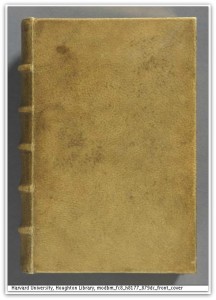“The Harvard Library has books bound in human skin” is one of those well-known fun facts that pop up a lot of place…including Uncle John’s Bathroom Reader. But we’re the trivia hounds who dig deeper. We wanted to know: what are those books?
 Binding books in human skin is a technique dating back to the 16th century and at one time so prevalent that it has a name: anthropodermic bibliopegy. It was most often used in Europe to bound the confessions of executed criminals…in their own skin. There may be as many as three human skin books in Harvard’s various library collections.
Binding books in human skin is a technique dating back to the 16th century and at one time so prevalent that it has a name: anthropodermic bibliopegy. It was most often used in Europe to bound the confessions of executed criminals…in their own skin. There may be as many as three human skin books in Harvard’s various library collections.
Arsene Houssaye’s Des destinées de l’ame
In the 1880s, Houssaye gave a manuscript of his book, his thoughts on the soul and the nature of the afterlife, to a friend named Ludivoc Bouland, a doctor and book collector who bound it in skin from an unclaimed cadaver of a dead mental patient. Why? According to the inscription, “A book about the human soul deserved to have a human covering.”
Ovid’s Metamorphoses
It hasn’t been confirmed or denied, but a 1597 French translation of Ovid’s Metamorphoses in Harvard’s medical library has a telltale leathery parchment cover. On the inside cover are penciled the words, “Bound in human skin.”
Juan Guitérrez’s Practicarum quaestionum circa leges regias Hispaniae (1605-06).
This legal text in Harvard’s law school library was rumored to be bound in skin for years. First of all, the cover feels like it is, all leathery and weird. It also bears this inscription: “The bynding of this booke is all that remains of my dear friende Jonas Wright, who was flayed alive by the Wavuma on the Fourth Day of August, 1632. King Mbesa did give me the book, it being one of poore Jonas chiefe possessions, together with ample of his skin to bynd it.” Only in the last 20 years has the technology been developed where extremely old parchments can be tested to find out what they are (or were). Harvard Law School asked Daniel Kirby, a conservation scientist at a Harvard-run museum to use peptide mass fingerprinting to analyze Practicarum. Kirby looked at the book’s front and back covers, binding, and glue with the peptide tests, which can identify proteins, and their animal source. Result: Practicarum was bound in sheepskin, and the glue was made from cattle and pig collagen. It would seem that the inscription is just a spooky prank that kept people going for almost 400 years.







